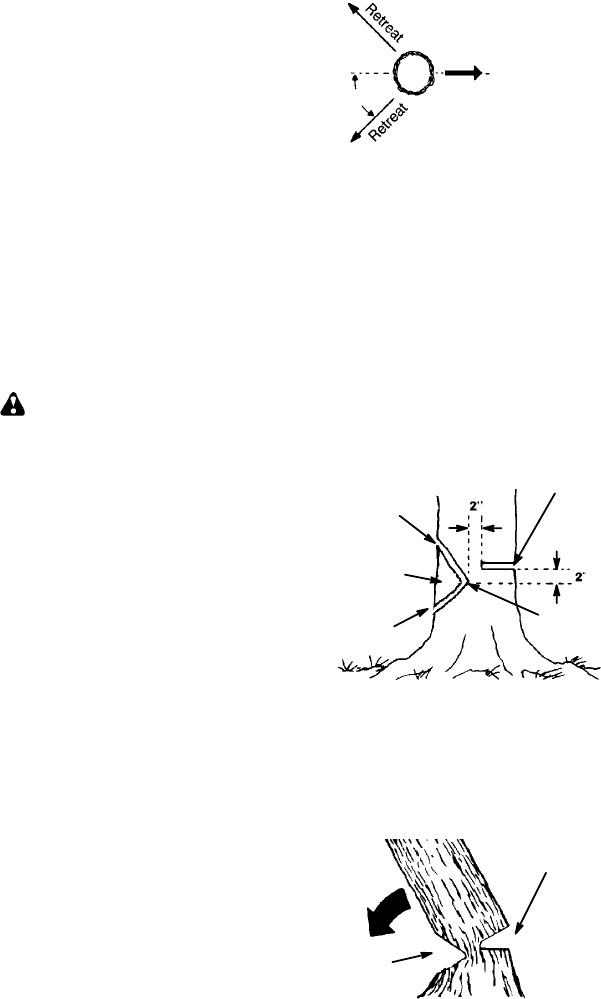
12
S Practice cutting a few smalllogs using the
following techniques to get the“feel” of us-
ing your saw before you begin a major
sawing operation.
S S queeze the throttle trigger and allow the
engine to reach full speed before cutting.
S B egin cutting with the saw frame
against the log.
S K eepthe engine at full speed the entire
time you are cutting.
S A llowthechaintocutfor you.Exertonly
light downward pressure. If you force
thecut,damage tothe bar,chain,oren-
gine can result.
S R elease the throttle trigger as soon as
the cut is completed, allowing the en-
gine to idle. If you run the saw at full
throttle withouta cutting load,unneces-
sary wear can occur to the chain, bar,
and engine. It is recommended that
the engine not be operated for lon-
ger than 30 seconds at full throttle.
S Toav oidlosingcontrolwhencut iscom-
plete,donotputpressureonsawatend
of cut.
S Stop the engine before setting the saw
down after cutting.
TREE FELLING TECHNIQUES
WARNING: Check for broken or
dead branches which can fall while cutting
causingserious injury. Do notcut nearbuild-
ings or electricalwires if you donot know the
directionof treefall, norcutat nightsinceyou
will not be ale to see well, nor during bad
weather such as rain, snow,or strongwinds,
etc. If the tree makes contact with any utility
line, the utility company should be notified
immediately .
S Carefullyplanyoursawingoperation inad-
vance.
S Clear the work area. You need a clear area
all around the tree so you can have secure
footing.
S The chain saw operat or should keep on
the uphill side of the terrain as the tree i s
likely torollorslidedownhillafterit isfelled.
S Study the natural cond itio ns th at can cause
the tree to fall in a particular direction.
Natural conditions that can cause a tree to
fall in a particular direction include:
S The wind direction and speed.
S The lean of the tree. The lean of a tree
might not be apparent due to uneven or
sloping terrain. Usea plumb o rlevel to de-
termine the direction of tree lean.
S Weight and branches on o n e side.
S Surrounding trees and obstacles.
Look for decay and rot. If thetrunk is rotted,
it can snap and fall t oward the operator.
Check for broken or dead branches which
can fall on you while cutting. Make surether e
is enough room for the tree to fall.
Maintain a distance of
2-1/2 tree lengths from
the nearest person or other objects. Engine
noise can drown out a warning call.
Remove dirt, stones, loose bark, nails, sta-
ples, andwire fromthe treewherecuts areto
be made.
Plan aclearretreat pathto therear anddiag-
onal to the line of fall.
Direction of Fall
45_
Plan a clear retreat path
FELLING LARGE TREES
(6 inches (15 cm) in diameter or larger)
The notch method is used to fell large trees.
A notchis cut onthe sideofthe treeinthede-
sired direction of fall. After a felling cut is
made on the opposite side of tree, the tree
will tend to fall into the notch.
NOTE: If the tree has large buttress roots,
removethembeforemaking thenotch. Ifus-
ing saw to remove buttress roots, keep saw
chain fromcontacting groundto preventdull-
ing of the chain.
NOTCH CUT AND FELLING THE
TREE
S Make notch cut by cutting the top of the
notch first. Cut through
1/3 of the diameter
ofthetree. Nextcompletethenotch bycut-
ting the bottom of the notch. See illustra-
tion. Once the notch is cut remove t he
notch of wood from the tree.
Notch
First cut
Second cut
Final (felling) cut here, 2 in ches
(5 cm) above center of notch.
Hinge
S After removing the wood from the notch,
make the felling cut on the opposite side of
thenotch. This isdone by makinga cutabout
two inches (5 cm) higher than the center of
the notch. This will leaveenough uncutwood
between the felling cut and the notch to form
a hinge. This hinge will help prevent the tree
from falling in the wrong direction.
Opening
of felling
cut
Closing of
notch
Hinge holds tree on stump a nd helps
control fall


















